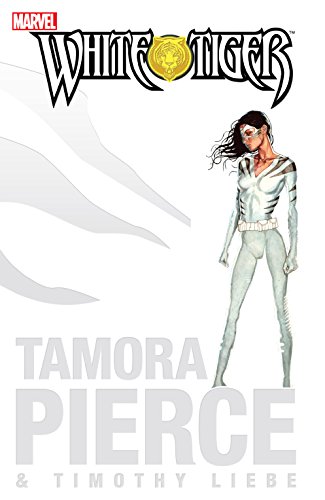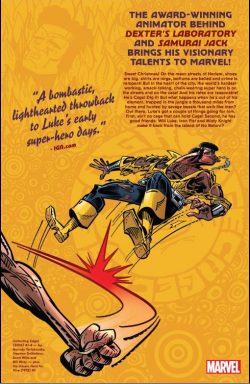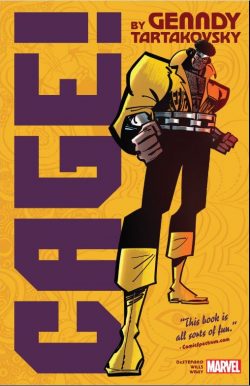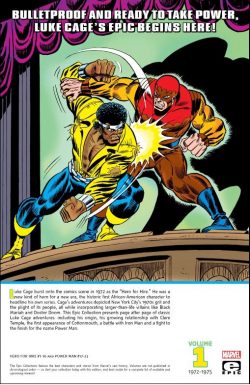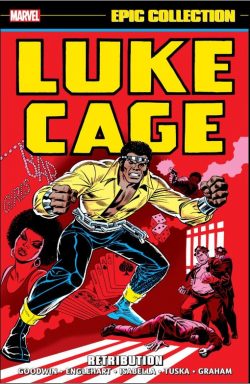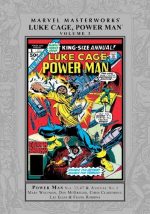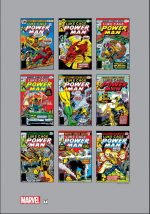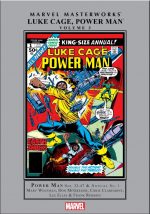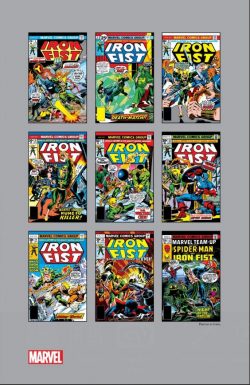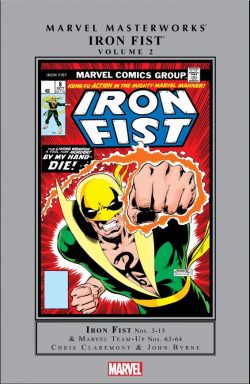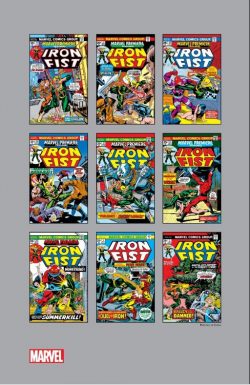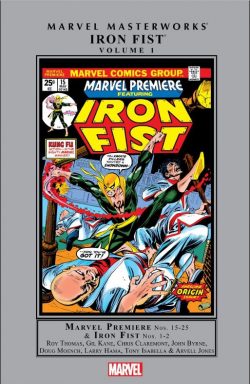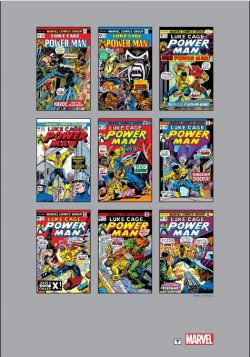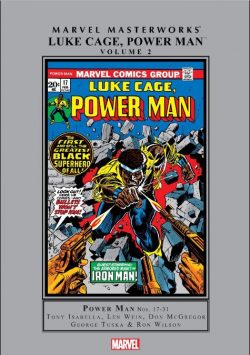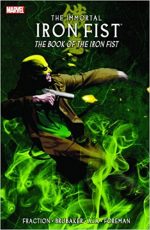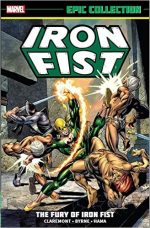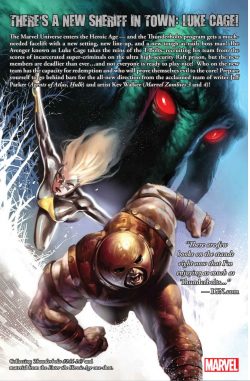
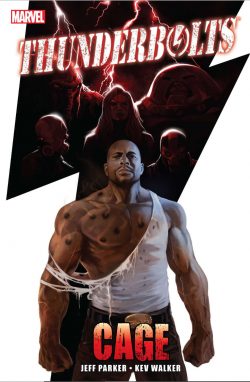
By Jeff Parker, Kev Walker & various (Marvel)
ISBN: 978-0-7851-4774-9 (HB/Digital) 978-0-7851-4775-6 (TPB)
At the end of 1996 the Onslaught publishing event removed The Fantastic Four, Avengers, Captain America and Iron Man from the Marvel Universe: rather unwisely handing over creative control to Rob Liefeld and Jim Lee for a year. For the early part of that period the “Image style” books got most of consumers’ attention, although a new title created to fill the gap in the “real” universe eventually proved to be the true breakthrough of that era…
Thunderbolts was initially promoted as a replacement team-book; untried champions pitching in because the big guns were dead and gone. They consisted of Captain America clone Citizen V, size-shifting Atlas, super-armoured Mach-1, energy-casting virago Meteorite, sonic siren Songbird and mechanised human weapon Techno.
A beleaguered and terrified populace instantly took them to their hearts, but these heroes shared a huge secret – they were actually super-villains in disguise and Citizen V (or Baron Helmut Zemo as he truly was) had nasty plans in mind…
Ultimately defeated by his own scheme as his criminal underlings (Mach-I AKA the Beetle, Techno/the Fixer, Atlas/Goliath, Songbird/Screaming Mimi and even deeply-disturbed Meteorite/Moonstone) increasingly yearned to be the heroic ideals they posed as, Zemo was ousted and the Thunderbolts thereafter carved out – under a succession of leaders – a rocky career as genuine, if controversial, champions.
Even with their Heroes Returned (a long story for another time) life got no easier for Earth and especially America. During the first superhero Civil War, the ever-changing Thunderbolts squad – generally comprised of felons looking to change their ways or escape punishment – became Federal hunters, tracking and arresting metahumans who refused to surrender to the Super-Human Registration Act. Eventually that iteration fell under the aegis of government hard-man Norman Osborn.
Through various deals, deeds and malign machinations former Green Goblin Osborn sought to control the Thunderbolt project as a stepping-stone to his becoming became the USA’s Security Czar…
As the “top-cop” in sole charge of a beleaguered nation’s defence and freedom, the psychotic Osborn controlled America’s costumed/metahuman community. Replacing super-spy agency S.H.I.E.L.D. with his own all-pervasive H.A.M.M.E.R. Directorate, the deadly despot had Captain America arrested and defamed. Setting the world’s heroes at each other’s throats, he dedicated all his energies to stealing political power to match his scientifically-augmented strength and overwhelming financial clout.
Numerous appalling assaults on the nation occurred, including a Secret Invasion by shape-shifting Skrull infiltrators and his own draconian, oppressive response – his Dark Reign – wherein Osborn drove the World’s Mightiest Heroes underground, replacing them with his own team of deadly Dark Avengers.
Not content with commanding the covert and military resources of the United States, Osborn personally led this team, wearing appropriated Tony Stark technology and calling himself the Iron Patriot: simultaneously betraying his country by conspiring with a coalition of major super-villains to divvy up the world between them.
He overreached himself by overruling the American President to direct an unsanctioned military Siege on godly citadel Asgard, and when the fugitive outlawed heroes at last reunited to stop him, Osborn’s fall from grace and subsequent incarceration led to a new Heroic Age.
In the aftermath, it was discovered that the Security Chief’s monstrous manipulations were even more Machiavellian than suspected. One of his initiatives was the kidnapping of super-powered children: tragic innocents he tortured, psychologically abused and experimented upon in a drive to create the next generation of fanatically loyal super-soldiers…
Those traumatised and potentially lethal kids became the responsibility of the exonerated and reassembled Avengers who decided to teach the surviving lab rats how to be heroes in a new Avengers Academy, whilst Osborn – beaten but not broken -was incarcerated in ultra-high-security penitentiary The Raft.
Collecting material from the Enter the Heroic Age one-shot and Thunderbolts #144-147 (July-October 2010) this new direction, written by Jeff Parker, illustrated by Kev Walker and coloured by Frank Martin, sees the Legion of the Lost reformed with a fresh brief and a new leader to once again offer penitence, potential redemption and probable death to the defeated dregs of the Marvel Universe…
For most of modern history black consumers of popular entertainments were provided with far too few fictive role models. In the English-speaking world that began changing in the turbulent 1960s and truly took hold during the decade that followed.
Many characters stemming from those days emerged due to a cultural phenomenon dubbed “Blaxploitation”. Although criticised for its seedy antecedents, stereotypical situations and violence, the films, books, music and art generated by the phenomenon were the first mass-market examples of minority characters in leading roles, rather than as fodder, flunkies or flamboyant villains.
If you care to look elsewhere in this blog, you’ll find a rather pompous review by (old, white) me detailing how that groundbreaking era led to the birth of superheroic cultural icon Luke Cage. You should read those stories: they’re groundbreaking landmarks and really good…
Here, however, the drama begins with the arrival on the high-tech island prison of Osborn and a new intake of monstrous convicts who pretty soon learned the ropes at the calloused hands of Power Man Luke Cage: former Hero for Hire, reserve Avenger and latest director of the Thunderbolts Program. The no-nonsense hard-man and former convict – albeit an innocent, framed and ultimately exonerated one – offered a last-chance way for some of America’s worst malefactors to pay back their immense debt to society and maybe buy a slice of salvation…
Issue #144 took up the story as new Warden John Walker (formerly super-soldier U.S.Agent before losing some limbs during the Siege of Asgard) and Cage begin selecting potential recruits in ‘The Boss’.
With original, genuinely reformed Thunderbolts Fixer and Mach-V as deputies, lethally ambivalent sociopath Moonstone opportunistically joins Cage’s team: the cream of a reluctant, conflicted and very bad bunch also comprising deranged phasing hacker Ghost; dispirited mystic mobile monolith Juggernaut and Captain America’s antithesis Cross-Bones – one of the most ruthless killers in existence.
Offering technical support is size-shifting Scientist Supreme/Avengers Academy headmaster Hank Pym (AKA Ant-Man, Goliath, Yellowjacket, The Wasp and Giant-Man), who devised a unique transport method for the penal battalion: one utilising unsuspected teleportational talents of the macabre, insentient monster called the Man-Thing…
However, before the unit can even undergo basic training, intransigent Zemo attacks the inescapable penitentiary, determined to reclaim his old team…
‘Field Test’ offers a surprise or two before Cage seizes control again and the squad set off on an emergency first mission: tracking down man-eating trolls ravaging the Oklahoma countryside and presumably escaped from Asgard after Osborn’s ill-fated attack on the dimensionally-displaced City of the Gods…
That grisly outing promptly segues into another crisis-response from the woefully untrained squad when dispatched to a New Guinea cave to rescue scientists and S.H.I.E.L.D. agents investigating mutagenic, metahuman-creating Terrigen crystals…
The mission is another tragic debacle. There is no cure for what the techs have uncovered and then become, so the salvation run turned into a grim and nasty bug hunt…
This sleek, effective thriller concludes its dramatic presentation with the intermediate part of a crossover tale which began and ended in Avengers Academy, offering some intriguing insights into the ongoing personal rehabilitation of troubled Juggernaut Cain Marko.
The students at the unique school were being trained under a hidden agenda: although officially declared the most accomplished of Osborn’s next generation protégés, sextet Reptil, Finesse, Striker, Hazmat, Mettle and Veil were actually diagnosed as the most experimented upon, abused and psychologically damaged. The Academy not only wanted to turn them into heroes but also intended to ensure the prodigies were not incurably corrupted, potential menaces…
‘Scared Straight’ reveals how toxic nightmare Hazmat, animated Iridium golem Mettle and slowly dissipating gas-girl Veil turn a school-trip to The Raft into an attempt to gain revenge on their erstwhile tormentor. Although the most secure and infallible jail on the planet, no one realises just what Hazmat can really do and when the power goes out she and her equally incensed classmates headed straight for Osborn’s solitary cell…
Their ill-conceived ploy also liberates an army of irate, murderous villains forcing the new Thunderbolts to prove how far they’ve come by choosing which side they are now on. More important than showing Cage and Warden Walker, the convicts and once-pariahs must examine their own unsuspected moral changes and how far they have progressed before order is finally, ruthlessly restored…
This collection confirming Luke Cage’s elevation from edgy outsider to first rank major player in Marvel continuity also comes with a superb cover gallery by Marko Djurdjevic, Bryan Hitch & Karl Kesel, Larry Stroman, Frank Martin, a wealth of character designs and pages of un-inked art from Walker to complete a wry, clever and suspenseful action-adventure package that all fans of gritty superhero action will adore…
© 2010, 2011 Marvel Characters, Inc. All Rights Reserved.

